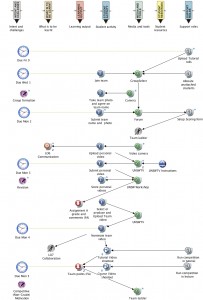Plagiarism spectrum & Did I Plagiarize? are beautiful, concise expressions of poor practice, but I wish we could focus instead on a spectrum of valuable scholarship.
Academic writing is a continuation of a worldwide, centuries-long conversation, and if my writing doesn’t connect to the conversation, or doesn’t advance it, I don’t count.
- Is it easy to verify the source of my ideas, words, images and data? (Unverified = untrustworthy.)
- Have I contributed any original understanding or expression? (No insight = insignificant.)

Credit: dave, 2004
Declarations of interest
Is it coincidence that the ideas for both charts are ultimately sourced from iParadigms, which profits from beliefs about plagiarism, while protesting that Turnitin is not a plagiarism detector?
Turnitin is important in my day job. I encourage academics to provide Turnitin in their courses, to allow students to check for unoriginal text before submitting their writing; and I train staff to use GradeMark to provide auditable, inline feedback on assignments to students.
Like most educationalists, I recognise emulation as a stage in a learning process.
References
iParadigms (2013) Does Turnitin detect plagiarism? Turnitin. Online at http://turnitin.com/en_us/resources/blog/421-general/1643-does-turnitin-detect-plagiarism retrieved 26/09/2014
iParadigms (2012) The Plagiarism Spectrum. Turnitin. Online at http://www.turnitin.com/assets/en_us/media/plagiarism_spectrum.php retrieved 26/09/2014
Newbold C (2014) Did I Plagiarize? TheVisualCommunicationGuy. Online at http://visual.ly/did-i-plagiarize-types-and-severity-plagiarism-violations retrieved 26/09/2014.
Schaum B, Stohrer M (2014) Plagiarism, Emulation, and Originality. Slideshare. Online at http://www.slideshare.net/beths0103/plagiarism-emulation-and-originality retrieved 26/09/2014.
dave (2004) pro_author. Morguefile. Online at http://mrg.bz/nH5vv9 retrieved 26/09/2014

